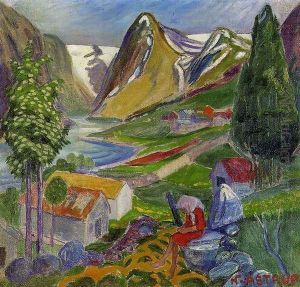Nicolai (Johannes) Astrup Paintings
Nicolai (Johannes) Astrup, a distinguished Norwegian painter and printmaker, was born on August 30, 1880, in Bremanger, but grew up in Jølster, a district known for its breathtaking landscapes in Sogn og Fjordane, Norway. His father was a Lutheran minister, and his upbringing in the picturesque, yet sometimes strict, religious environment of rural Norway significantly influenced his artistic vision. Astrup's unique style is characterized by its vivid use of color and intimate portrayal of the Norwegian countryside, making him a central figure in the art history of Norway.
Astrup showed an early interest in art, drawing and painting the landscape of his childhood from a young age. Despite his father's wishes for him to enter the priesthood, Astrup pursued his passion for art. He studied at the Royal Drawing School (now the National Academy of Craft and Art Industry) in Kristiania (now Oslo) but found the education there too restraining. Seeking a more comprehensive artistic education, he moved to Paris in 1901 to study under Christian Krohg, a leading Norwegian naturalist painter, who had a significant influence on Astrup's early work.
Returning to Norway, Astrup settled in Jølster around 1902, where he would spend most of his life. His work deeply reflects his connection to the Norwegian landscape and rural life, blending elements of Art Nouveau with Norwegian folk art traditions. He is particularly celebrated for his innovative techniques in woodcut prints and for his expressive use of color in landscapes that often depict the lush Norwegian countryside, traditional festivals, and scenes from daily life.
Astrup's health was always fragile, and he struggled with tuberculosis throughout his life. Despite his illness, he worked prolifically, leaving behind a rich body of work that includes paintings, woodcuts, and drawings. His approach to art was deeply personal and rooted in his experience of the natural world and the cycles of life and death, themes that recur throughout his oeuvre.
Nicolai Astrup died on January 21, 1928, in Jølster. Although he gained some recognition in his lifetime, his work was somewhat overshadowed by other Norwegian artists such as Edvard Munch. However, in recent years, Astrup's contributions to art have been re-evaluated, and he is now regarded as one of Norway's most important and beloved artists, celebrated for his distinctive interpretation of Norwegian nature and culture. His work is held in numerous collections both in Norway and internationally, including the National Museum of Art, Architecture and Design in Oslo, and continues to inspire new generations of artists and art lovers alike.
